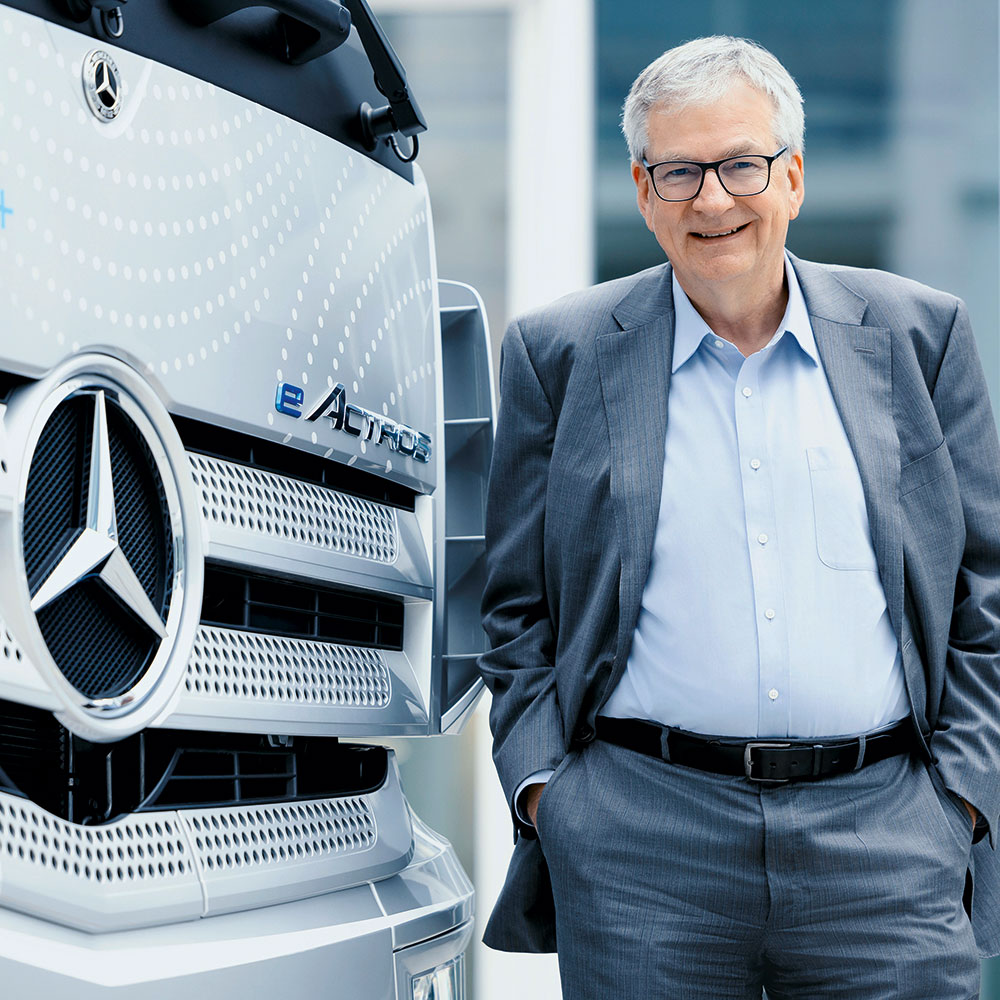Martin Daum, CEO of Daimler Truck AG
Fraunhofer magazine 3.2023
Batteries are the hottest topic of conversation right now – and not just at the upcoming IAA Mobility trade fair in September. Battery-powered propulsion is the numberone technological option for making automotive traffic emission-free. However, trucks are not just big cars.
The commercial vehicles of the future will not only need batteries – they will also need hydrogen. At Daimler Truck, we are well aware of this, which is why we signed a memorandum of understanding with the Toyota Motor Corporation a few months ago. As well as outlining plans to merge our Japanese commercial vehicle subsidies, this agreement also concerns collaborating on hydrogen propulsion. In addition, in 2021, we formed the cellcentric joint venture with the Volvo Group to build one of the largest production facilities for fuel cells in Europe. In contrast to our colleagues in the passenger car sector, we are not pursuing a single technological strategy, but rather heading down a two-track road – and we have a good reason for that.
First of all, trucks are not just big cars. They are capital goods. Our customers must be able to earn money using our products. That means they keep a close eye on costs. And not just the purchasing costs, but also specifically the overall costs throughout a truck’s working life. These costs currently depend very much on the price of diesel – and in the future, they will depend on the prices of electricity and hydrogen. Depending on how these prices develop, it may be more economical for commercial vehicle customers to choose battery or fuel cell propulsion.
When it comes to trucks and long-distance buses in particular, energy prices will greatly influence customers’ purchasing decisions. However, we cannot predict future price levels — so we also cannot predict the future mix of battery and fuel cell vehicles. This means companies that are not developing hydrogen drives at present could lose out in the future, when the market for hydrogen models may be booming. One more important thing — in addition to fuel cells, there is another form of hydrogen production: the hydrogen combustion engine. This technology is a good CO2-free alternative for trucks that have vehicle platforms, such as construction site vehicles, and thus require significantly more energy than is used just for driving. For this reason, we are following current discussions around hydrogen combustion engines very closely. If this concept receives well-founded political support, we will be well prepared and quickly be able to offer vehicle series of this kind.
A second reason for our two-pronged strategy is the infrastructure. A few facts clearly show what it would mean for zero-emission trucks to be powered with batteries alone in the future. First, if that were the case, every truck stop would require between 20 and 50 charging stations. And every charging station would need to be equipped for megawatt charging. This means every truck stop would need as much energy as a small town. That type of charging infrastructure is pure fantasy. Providing widespread public access to this amount of charging capacity is simply not realistic. It would overtax power grid expansion efforts beyond all hope of recovery. Just for this reason alone, we will also need hydrogen for trucks in the future – in addition to batteries. And we must note another fact too: As the consulting firm McKinsey found in a study, when it comes to costs, building two infrastructures is cheaper than just building one. Intuitively, you might expect a different result. But taking an infrastructure that’s just based on batteries and scaling it up to an extreme volume is more expensive than scaling two infrastructures – one for batteries and one for hydrogen – up to a medium volume.
The third reason concerns the European continent’s energy needs. In order to make Europe more sustainable, we need to completely replace the energy produced from fossil raw materials with green energy sources. The amounts involved are so enormous that we cannot produce them in Europe, where we get comparatively little sunshine. But the good news is, there’s more than enough green energy available worldwide. Every day, the Earth’s land mass is hit with 15 times as much solar energy as we consume worldwide in a whole year. We just need to capture it and transport it to where it is needed. However, for this purpose, we need a carbon-free energy carrier that can be traded worldwide – and with that, we have now circled back to hydrogen. So what we can take away here is that we need to develop a hydrogen economy to support the sustainable industry of tomorrow – and there are good reasons to use this energy carrier for trucks and buses too. This is why commercial vehicle manufacturers need to take a two-track road to reach the future.
